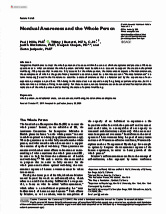By Naveen Jain and Deepak Chopra™, MD
Some pessimism has been circulating about lifespan recently. In the modern era lifespan has increased every decade, and dying before you turn seventy would now be considered a premature death. Three score and ten is no longer a destination for a normal life, and average lifespans among people who are not underprivileged could easily top ninety in the near future.
The difference in quality of life is now more important than lifespan on its own, because the health status of two seventy-year-olds can vary wildly. The concept to keep in mind is healthspan, defined as the years you spend without infirmity, chronic disease, and dementia. Right now healthspan is a hit and miss proposition.
While we are told that our genes determine how we age, this needs to be clarified. Research on identical twins reveals that it’s not your genes that determine your healthspan but your lifestyle, nutrition, and gut microbiome that play a much more important role. Identical twins are born with the same genes, a fact that will not change over the decades, but by age seventy, many identical twins are as unalike in their health status as two people chosen at random.
What makes the difference is known as gene expression. DNA is an inactive molecule, but its expression into active molecules (proteins), is influenced by all the factors that determine the difference between aging well or badly. The active side of genetics belongs to the field of epigenetics, which controls whether a gene is turned on or off. You carry around at the epigenetic level all the major experiences of your lifetime. As these accumulate, they automatically divide into experiences that promote a long healthspan and those that do the opposite.
Here is where a breakthrough is possible that could make an enormous difference. We said that you cannot change the genes you were born with, which has been gospel in genetics for decades. Even though you can not change the genes you are born with, you can change their expression, which is what matters. Also, 90% of your genes are not in your cells but in your gut microbiome. Trillions of bacteria in your digestive tract do more than digest food. They constitute an immense chemical factory sending messages to every part of the body. Humans have evolved in cooperation with these bacteria. They are not alien or separate from you; they are part of your evolution, affecting you every moment.
Chemical messages can be harmful, such as those that create inflammation or promote stress, or beneficial. Your microbiome is unique to you and constantly shifting. In essence, you are changing the vast majority of your genes through your lifestyle, for the gut microbiome amounts to 90% of your genes. The genes you were born with amount to only 10% of your total genome. The good news here is that you can change their expression, also.
Healthspan, therefore, depends on living in such a way that the entire genetic complement functions properly. The enemies of beneficial gene expression are now pretty well known:
- Impure water, air, and food
- Lack of hygiene and sanitation
- Stress
- Chronic inflammation
- Depression and anxiety
- Toxins like alcohol and tobacco
- Sedentary lifestyle
- Inherited predisposition (normally a minor factor if you are healthy)
These negative factors take years to develop before symptoms appear and a doctor must be visited. In the meantime, people shorten their healthspan simply through everyday choices. It’s the small things accumulating over a long time that determine who is healthy at seventy and who isn’t. Similarly, the choices that support the best functioning at the cellular level are well know.
- Pure food, water, and air
- Absence of additives and toxins
- Moderate physical activity
- Meditation
- Lowered stress
- Good level of mood
- Close fulfilling relationships
- Having a good support system
- Overall happiness and well-being
These influences go far beyond preventive medicine and depending on a doctor to keep you healthy. You can lower your biological age by the choices you make, and your entire complement of genes will benefit. They express the benefit by exchanging chemical messages that promote their own lives at the cellular level. Those messages are chemical and therefore do not speak in the language humans share. But every aspect of consciousness, going beyond the physical, lies at the heart of healthspan.
That’s why a direct connection can be made between meditating, even for a short period, and the level of telomerase in your cells. Telomerase is a chemical that is vital to keeping DNA intact without fraying from age. It took years of intense research to uncover the role of telomerase, yet the bottom line is that your consciousness, not just your positive lifestyle choices, is key to what your cells are doing, including the one-celled microbes in your intestinal tract.
More importantly, however, is the message that healthspan should be everyone’s top priority when thinking about present and future health. What makes you young and keeps you young is the healthy functioning, right this minute, of your cells and microbiome. How do you actually know that your lifestyle is contributing towards healthy aging or in other words are you biologically becoming younger or older than your chronological age. Viome is a company that recently launched a health intelligence service that gives you insight into your microbial health, cellular health, immune system health, mitochondrial health, stress response health and your biological age. For fair disclosure authors are founders and advisor to Viome. Your microbiome are living solely for your benefit, and by giving them some attention in return, you are caring for your future far beyond what a doctor can do after symptoms appear.

 New Research Paper out now!
New Research Paper out now!